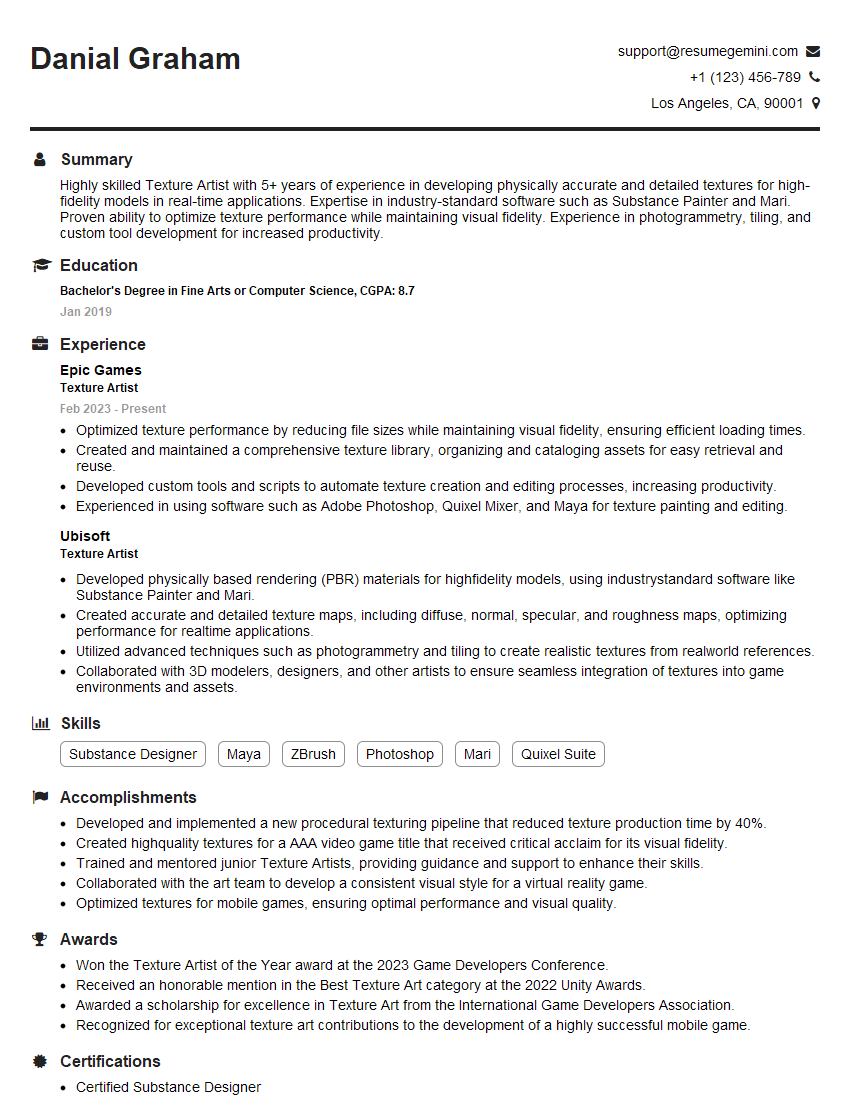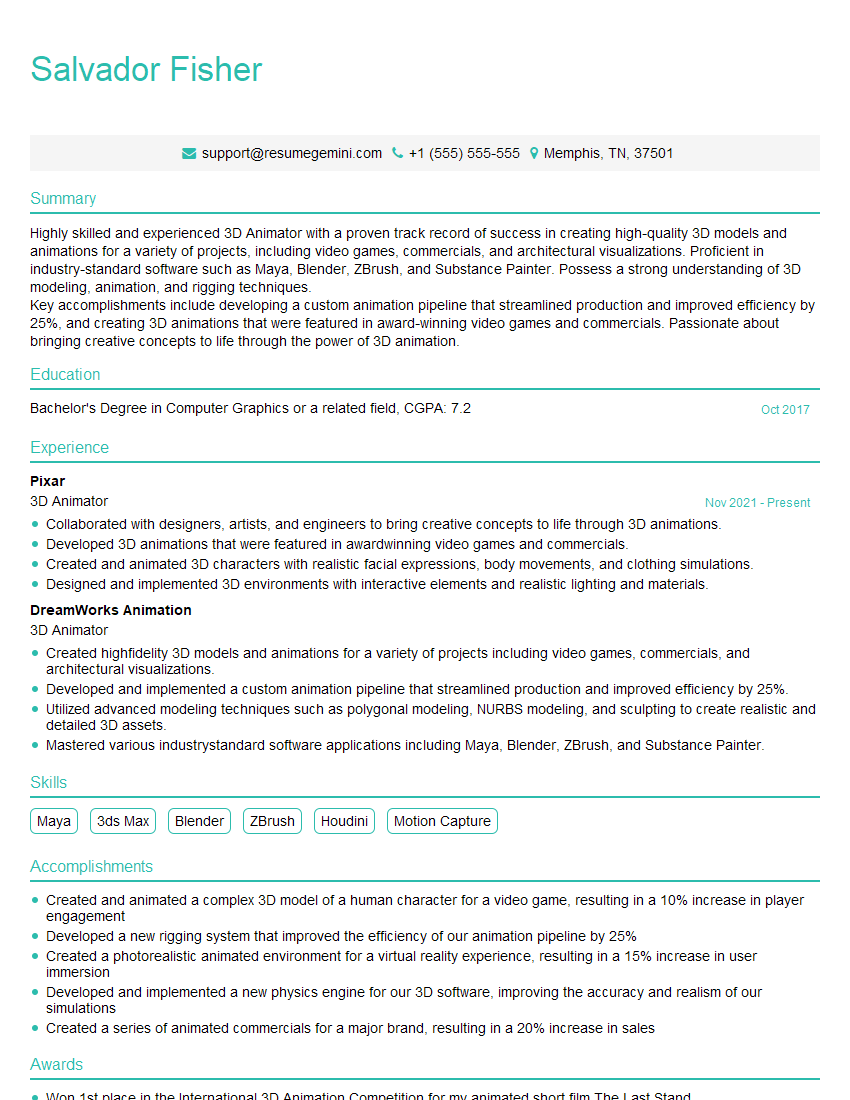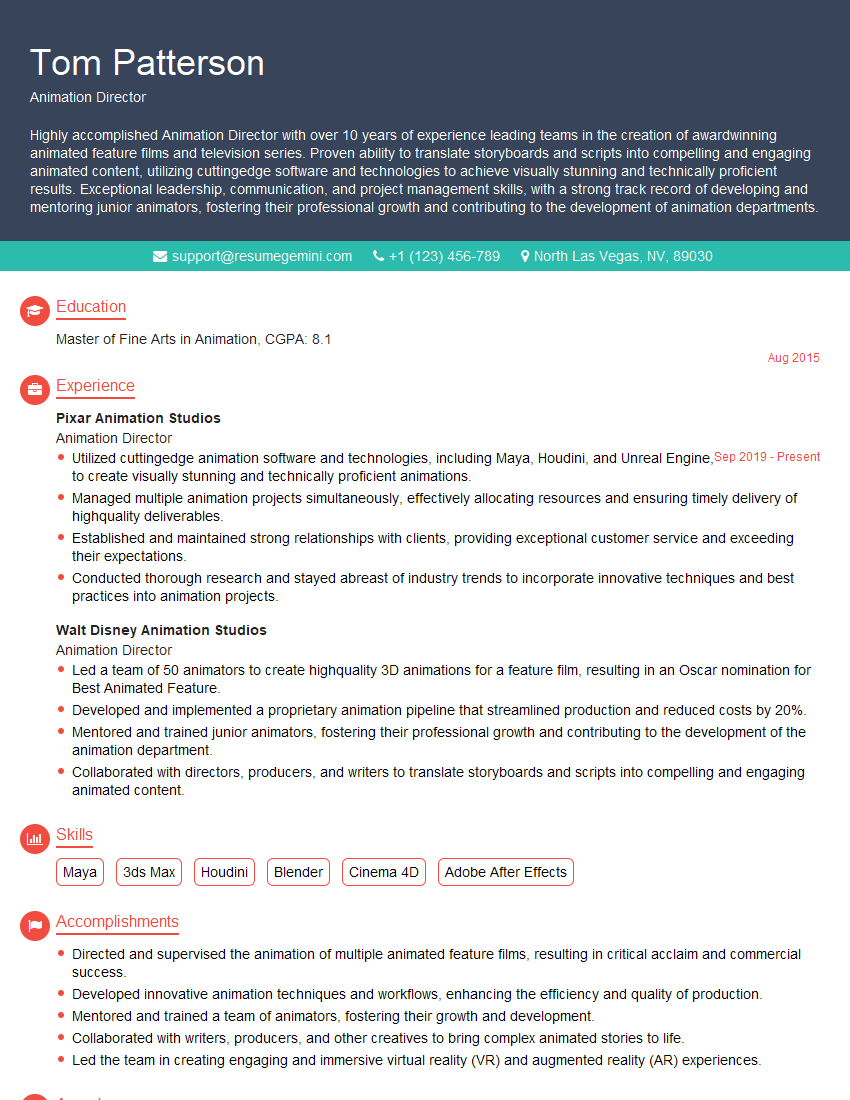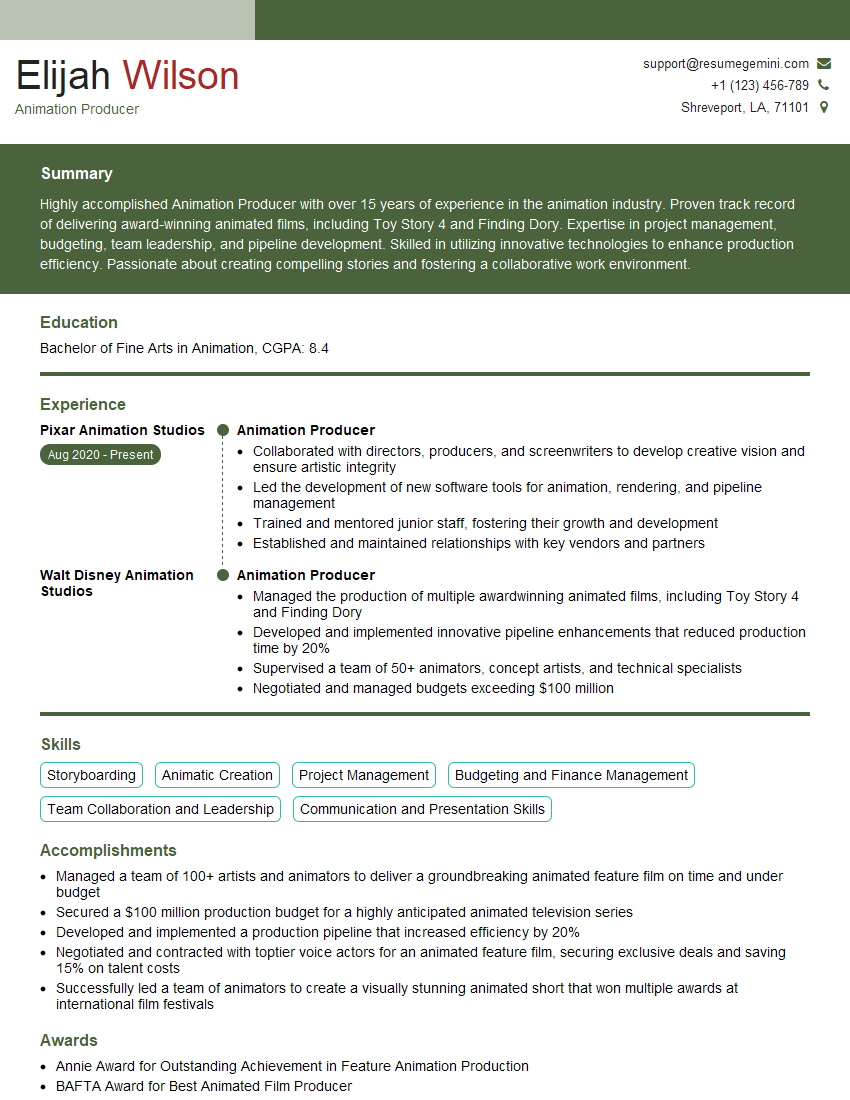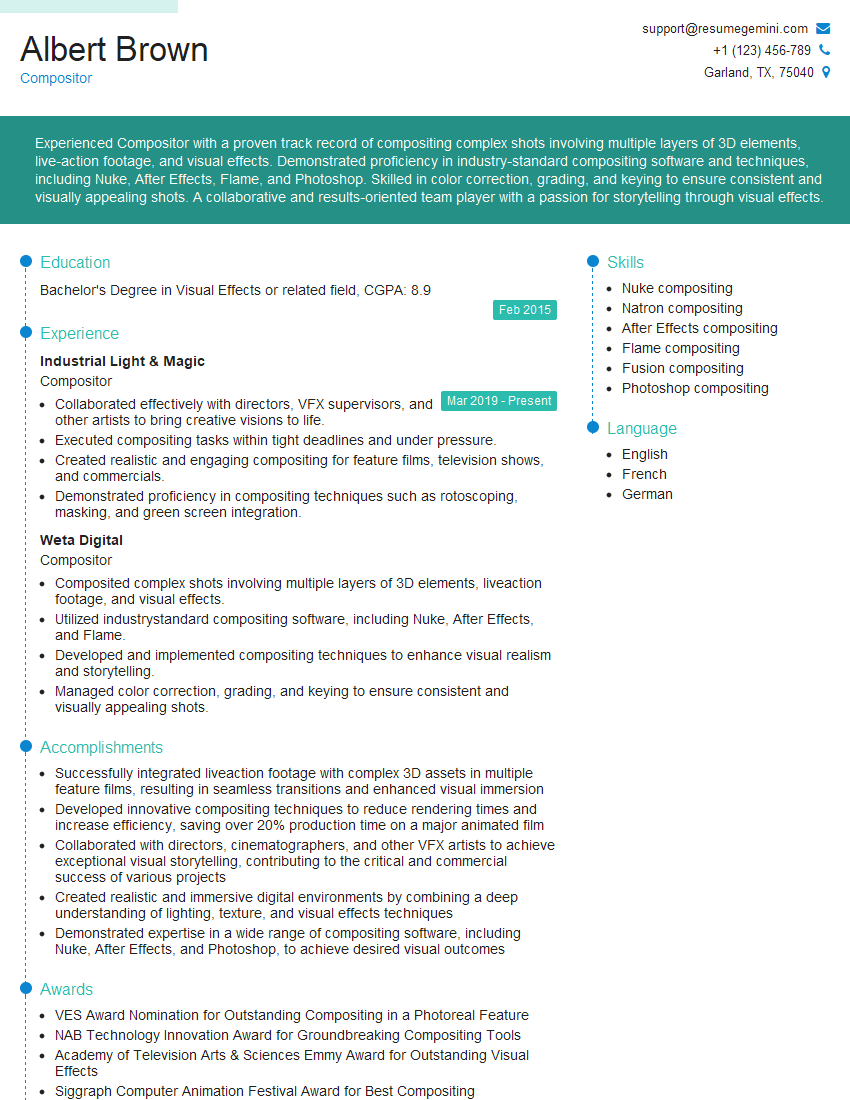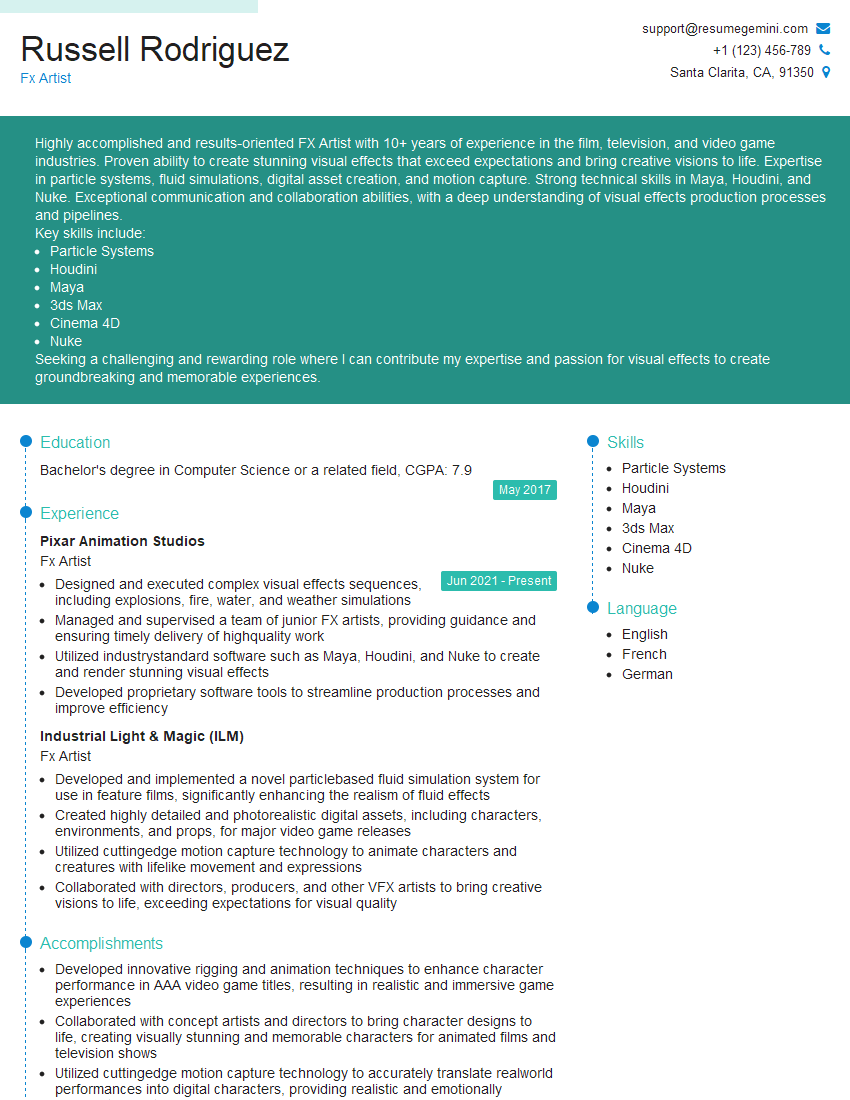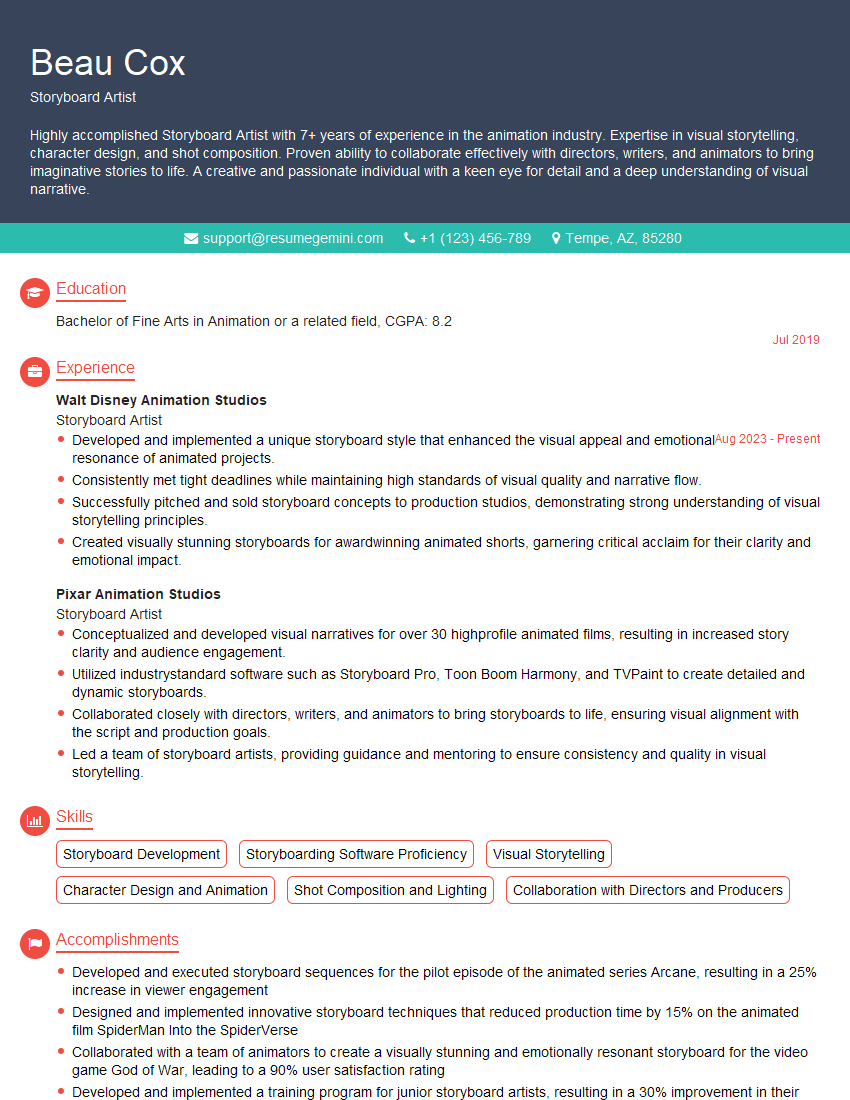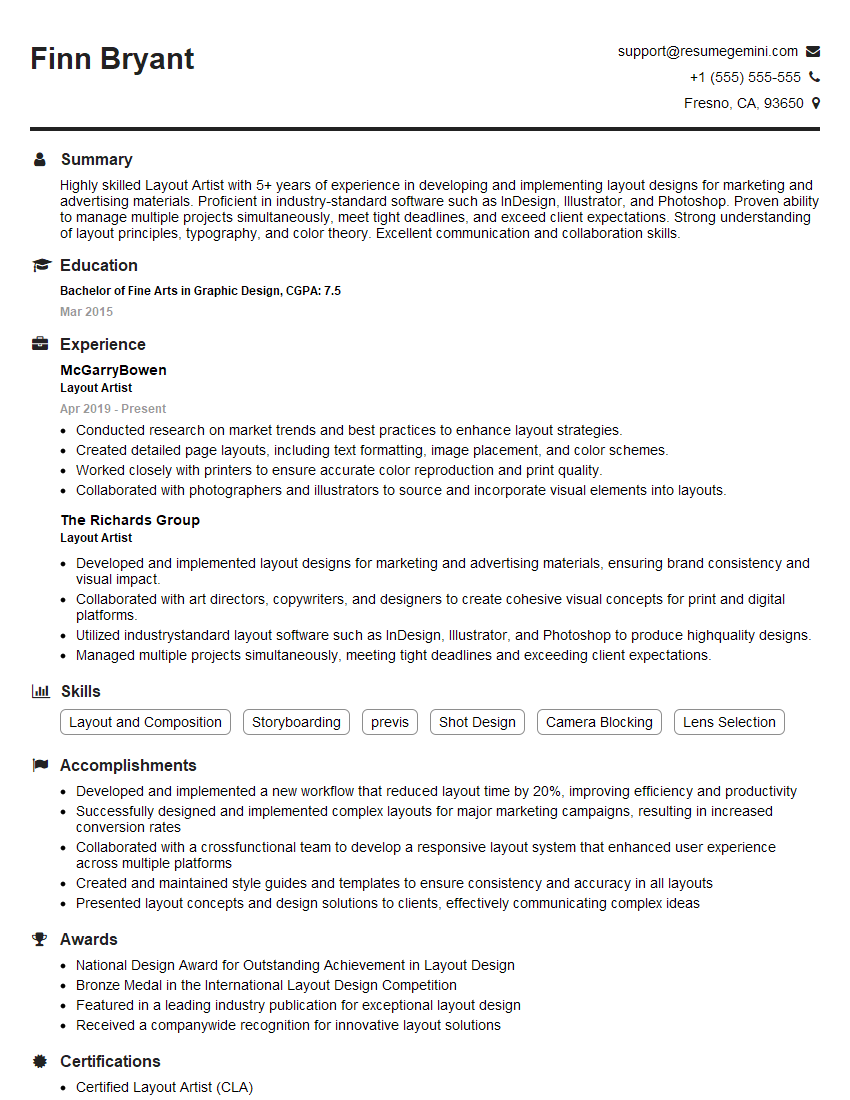Unlock your full potential by mastering the most common Experience with Animation Projects interview questions. This blog offers a deep dive into the critical topics, ensuring you’re not only prepared to answer but to excel. With these insights, you’ll approach your interview with clarity and confidence.
Questions Asked in Experience with Animation Projects Interview
Q 1. Explain your experience with different animation techniques (e.g., keyframing, motion capture, procedural animation).
My experience encompasses a wide range of animation techniques. Keyframing, the foundation of most animation, involves setting key poses at specific frames, letting the software interpolate the in-between movements. I’ve extensively used this for creating smooth, controlled character animations and subtle object movements. For example, I once used keyframing in Maya to animate a realistic-looking walk cycle for a bipedal robot character, paying close attention to the weight shift and subtle leg and arm movements.
Motion capture (MoCap) offers a more performance-driven approach. I’ve worked with MoCap data to capture realistic human and animal movements, then refined and stylized the data within animation software like Blender. In one project, we used MoCap to animate a character’s fight scene, transferring the raw data’s energy and realism while still adding stylistic choices to fit the overall aesthetic. Finally, procedural animation leverages algorithms and code to generate animations automatically. I’ve experimented with this to create things like realistic crowd simulations or complex effects like flowing water or fire, using tools and scripting within After Effects to automate repetitive tasks.
Q 2. Describe your experience with various animation software (e.g., Maya, Blender, After Effects).
My proficiency spans several industry-standard animation packages. Maya is my primary tool; its robust features are indispensable for high-end character animation and rigging. I’ve worked on projects extensively using Maya’s modeling, animation, and rendering capabilities. Blender, an open-source alternative, has also been valuable for personal projects and prototyping. Its versatile nature allows for quick experimentation and exploration of various styles. After Effects is a crucial component of my workflow, especially for compositing, visual effects, and creating motion graphics. For instance, I frequently use After Effects to integrate 2D elements into 3D animations, enhancing visual storytelling. Each software has its strengths, and my comfort with multiple platforms allows me to choose the optimal tool for each project’s specific requirements.
Q 3. How do you approach creating realistic character movements?
Creating realistic character movements involves a deep understanding of anatomy, physics, and acting. I begin by studying reference material, observing how real people or animals move, and paying attention to subtle details like weight transfer, momentum, and anticipation. This might involve video analysis, anatomical studies, or even working with actors to capture natural performances. In the software, I focus on creating believable arcs of motion, using keyframes and curves to define speed and acceleration. For instance, a realistic walk cycle requires a smooth transition between the stance and swing phases, with proper weight shift and subtle upper-body adjustments. I frequently use secondary animation—smaller, subtle movements in limbs and clothing—to add a level of realism and character to the primary animation.
Q 4. How do you handle feedback during the animation process?
Feedback is crucial to the animation process. I actively seek it out and view it as an opportunity for improvement. My approach involves establishing clear communication channels with the director, clients, and other team members. I always schedule regular feedback sessions where I can present work-in-progress, address specific concerns, and discuss possible revisions. I’m adept at receiving constructive criticism; I focus on understanding the feedback’s intention and implementing it effectively, while also articulating my creative choices and justifications. I believe in iteration and refinement; feedback helps guide the animation toward its best possible form, ensuring alignment with the project’s overall vision.
Q 5. Describe your workflow for creating a short animation clip, from concept to final render.
My workflow for a short animation clip typically follows these stages: 1. Concept and Storyboarding: I begin with a clear understanding of the narrative and visual style. Storyboarding helps visualize the sequence of shots and actions. 2. Animatic: A rough animation using simple shapes and placeholder sounds is created to test timing and pacing. 3. Character and Environment Modeling/Rigging: This stage involves creating the 3D models of characters and the environment, followed by setting up rigs that allow for animation. 4. Animation: This is where the core animation work happens, using techniques like keyframing, motion capture, or procedural animation. 5. Lighting and Texturing: This stage adds visual detail and realism to the scene. 6. Compositing and VFX: This is where additional elements are integrated to enhance the final visual product. This might include adding special effects or integrating 2D elements. 7. Rendering: The final output is generated. 8.Review and final adjustments: A final review is carried out to ensure everything meets the client’s expectations. This process is iterative; revisions might be needed at any stage.
Q 6. How do you troubleshoot technical issues that arise during animation production?
Troubleshooting technical issues is a routine aspect of animation production. My approach is systematic: 1. Identify the problem: pinpoint the exact nature of the error. 2. Isolate the source: determine which aspect of the software or pipeline is causing the problem. 3. Consult documentation and online resources: research solutions. 4. Test and debug: systematically test potential solutions and iterate until the problem is resolved. 5.Seek help if necessary: Collaborate with colleagues or online communities. Common issues include rigging glitches, rendering errors, software crashes, or compatibility problems. Experience allows me to quickly diagnose and resolve most issues, but I also know when to reach out for assistance from more experienced professionals or online communities.
Q 7. What are your preferred methods for creating believable character expressions?
Creating believable character expressions involves understanding facial anatomy and the subtle interplay of muscles. I start by studying reference materials – photos, videos, and even anatomical drawings – to grasp the nuances of human expression. In my workflow, I utilize a blend of techniques. I might sculpt subtle variations in the facial geometry, use shape keys or blendshapes within the animation software (such as Maya’s shape keys), or even work with facial rigging systems that offer precise control over individual facial muscles. I also pay close attention to the timing and subtlety of expressions; a slight twitch of the eyebrow can convey more emotion than a wildly exaggerated grimace. For example, to create a believable surprised expression, I might subtly raise the eyebrows, widen the eyes, and slightly open the mouth, all while ensuring smooth transitions to avoid a jarring effect.
Q 8. Explain your understanding of animation principles (e.g., squash and stretch, anticipation, staging).
Animation principles are the foundational rules that govern believable and engaging movement. They’re like the grammar of animation, ensuring fluidity and emotional impact. Let’s explore some key principles:
- Squash and Stretch: This involves distorting an object’s shape to emphasize its weight, mass, and momentum. Think of a bouncing ball – it squashes on impact and stretches as it rebounds. This adds realism and a sense of elasticity.
- Anticipation: Before a character performs an action, they often prepare for it. For example, a character winding up for a punch subtly shifts their weight and prepares their muscles. This prepares the viewer for the main action and makes it more believable.
- Staging: Staging is all about clarity. It’s making sure the focus is on the action or expression you want the viewer to see. This might involve camera angles, character positioning, and clear body language.
- Follow Through and Overlapping Action: This describes how different parts of a character move at slightly different speeds. For instance, a character’s hair might continue to sway even after they’ve stopped running. This creates more lifelike and natural movement.
- Slow In and Slow Out: Most natural movements start and end slowly, with the middle section being faster. This creates a sense of weight and realism. Imagine a pendulum swinging; it slows at the extremes of its arc.
- Arcs: Most natural movements follow curved paths, rather than straight lines. This is particularly evident in limb movements and projectile motion. Think of the arc of a ball thrown in the air.
- Secondary Action: Adding secondary actions complements the main action and enhances the character’s personality. A character walking might also swing their arms or talk, adding depth to the performance.
- Timing: This refers to the number of frames used for an action, determining its speed and weight. A heavier object will typically have slower timing than a lighter one.
- Exaggeration: While realism is important, exaggeration helps to emphasize expressions and actions, making them more impactful and memorable. It’s about pushing the limits of reality for visual effect.
- Solid Drawing: Solid drawing refers to understanding and accurately depicting form, weight, and volume. It’s about drawing with precision and anatomical accuracy, particularly when depicting characters.
Understanding and applying these principles is crucial for creating animations that are not only visually appealing but also emotionally resonant and believable.
Q 9. Describe your experience working with rigging software.
My experience with rigging software is extensive. I’ve worked extensively with Autodesk Maya and Blender, creating rigs for both 2D and 3D character animation projects. My workflow typically involves:
- Skeleton Creation: Building a robust skeletal structure tailored to the character’s needs, considering its range of motion and potential deformations.
- Joint Placement: Carefully positioning joints to allow for natural and believable movement, paying close attention to anatomical accuracy.
- Skinning: Connecting the skeleton to the character’s geometry (mesh) for smooth and consistent deformation. This involves careful weight painting to ensure the skin moves correctly with the rig.
- Controls and Constraints: Creating intuitive controls for animators, employing techniques such as IK/FK switching (Inverse Kinematics/Forward Kinematics) to streamline the animation process. This also involves setting up constraints to ensure realism and efficiency.
- Rig Testing and Refinement: Thorough testing of the rig to identify and fix any issues with deformation or control, ensuring smooth and predictable movement across the full range of motion.
In a recent project, I developed a complex rig for a quadrupedal character in Maya. This required careful consideration of the animal’s unique anatomy and movement patterns. I utilized custom scripts to automate repetitive tasks and improve efficiency. The final rig allowed for natural and nuanced animation, including detailed facial expressions and realistic gait cycles.
Q 10. How do you manage time effectively on large animation projects?
Managing time on large animation projects requires a structured and proactive approach. I rely heavily on:
- Detailed Planning: Breaking down the project into manageable tasks with clear deadlines. This often involves creating a detailed shot breakdown and schedule, specifying the required tasks for each shot.
- Agile Methodologies: Employing iterative workflows, regularly reviewing progress and adjusting plans as needed. This ensures flexibility and quick responses to emerging challenges.
- Time Tracking: Accurately tracking time spent on each task to identify potential bottlenecks and areas for improvement. Tools like Toggl or similar are invaluable here.
- Prioritization: Focusing on critical path tasks to ensure timely completion of the project. This often involves collaborating with the team to ensure all tasks are prioritized effectively.
- Communication: Open and consistent communication with team members to stay aligned and address potential delays proactively. This includes regular status meetings and progress updates.
- Risk Management: Identifying potential roadblocks and developing contingency plans to mitigate their impact. This can involve having backup plans for challenging tasks or scenarios.
For instance, on a previous feature film project, we used a Kanban board to track shot progress, which greatly improved transparency and accountability. Regular stand-up meetings allowed us to address emerging issues immediately, preventing minor problems from escalating into major delays.
Q 11. How do you collaborate effectively with other members of an animation team?
Effective collaboration is paramount in animation. My approach centers on:
- Clear Communication: Maintaining open and honest communication with all team members, using various tools like Slack, email, and in-person meetings to facilitate information sharing.
- Shared Understanding: Ensuring everyone has a clear grasp of project goals, timelines, and individual responsibilities. This often involves detailed briefings and project kick-off meetings.
- Constructive Feedback: Providing and receiving constructive criticism in a respectful and supportive manner. This fosters an environment of continuous learning and improvement.
- Version Control: Utilizing version control systems (e.g., Perforce, Git) for collaborative work on assets, ensuring that everyone works with the latest approved versions.
- Teamwork and Support: Fostering a supportive and collaborative team environment where individuals feel comfortable seeking help and offering assistance. This creates a strong sense of shared responsibility.
I believe in fostering a collaborative environment where everyone feels valued and their contributions are recognized. On a recent project, our team used a shared online platform to review work in progress, allowing for real-time feedback and collaboration. This streamlined our workflow and improved the overall quality of the final product.
Q 12. Describe your experience working with different file formats and pipelines.
Experience with various file formats and pipelines is essential in animation. I’m proficient with industry-standard formats like:
- FBX: A common interchange format for 3D models and animation data.
- OBJ: A simpler format for exchanging 3D geometry.
- Alembic (.abc): Used for caching complex simulations and animation data.
- Textures (TGA, PNG, JPG): For surface details and color information.
My experience with pipelines involves working with different software packages and understanding how to seamlessly transfer assets and animation data between them. I’m familiar with both linear and non-linear pipelines and understand the intricacies of managing file versions and ensuring data integrity. For example, I’ve worked on projects where assets were created in Maya, textured in Substance Painter, and rendered in Arnold. The experience highlighted the importance of well-defined asset naming conventions and a solid understanding of each software’s strengths and limitations to manage the project successfully.
Q 13. How do you balance creative vision with technical constraints?
Balancing creative vision with technical constraints is a constant challenge in animation. I address this by:
- Early Problem Solving: Identifying potential technical challenges early in the project and developing solutions collaboratively with the technical team.
- Iterative Refinement: Approaching the creative process iteratively, making adjustments as needed based on technical feedback and limitations.
- Realistic Expectations: Setting realistic expectations for both the creative team and the technical team, ensuring everyone understands the capabilities and limitations of the technology being used.
- Compromise and Collaboration: Finding creative solutions that compromise between artistic vision and technical feasibility. Open communication is key here.
On a past project, we faced constraints in rendering time due to the complexity of the scene. This involved closely collaborating with our technical director to find methods for optimizing the model and rendering settings, while ensuring our artistic vision remained mostly intact. By implementing techniques like level of detail (LOD) and efficient shader usage, we managed to minimize render times without sacrificing the quality of the final product.
Q 14. What strategies do you use to optimize animation performance?
Optimizing animation performance requires a multi-faceted approach:
- Efficient Rigging: Creating a well-structured and optimized rig to minimize the computational cost of animation. This includes using efficient control systems and avoiding unnecessary joints.
- Geometry Optimization: Using low-poly models and optimizing the mesh topology to reduce the number of polygons. This can greatly improve rendering performance without sacrificing visual quality.
- Caching: Utilizing caching techniques like Alembic to store complex simulations and animation data, reducing the processing load during playback and rendering.
- Animation Optimization: Avoiding excessive keyframes and optimizing animation curves to reduce the number of calculations needed. Simplifying animation where possible without impacting the overall quality is key here.
- Rendering Optimization: Using appropriate rendering settings and techniques, such as proper use of ray tracing and global illumination options to balance visual quality and render time.
In a recent project, we implemented a combination of these techniques, including level of detail (LOD) models for background elements and optimized animation curves. These steps resulted in significant improvements in render times, without compromising the artistic quality of the final animation.
Q 15. Explain your experience with motion capture data processing and integration.
Motion capture (mocap) data processing and integration is a crucial part of bringing realistic movement to animated characters. It involves capturing an actor’s performance using specialized cameras and sensors, then cleaning, retargeting, and finally integrating that data into a 3D animation software.
My experience encompasses the entire pipeline. I’m proficient in using software like Autodesk MotionBuilder and Maya to process raw mocap data. This involves cleaning noisy data, removing extraneous movement, and editing the captured performance to match the needs of the animation. For example, I’ve worked on projects where an actor’s performance needed to be adapted to a different character rig—a process known as retargeting. This requires careful consideration of the character’s anatomy and the subtleties of movement. Finally, integrating the processed mocap data into the animation software involves aligning it with the character’s skeleton and adjusting the animation to blend seamlessly with keyframed animation or simulated effects.
One project involved capturing a complex fight scene. The raw data was noisy due to equipment limitations. I used various filtering techniques within MotionBuilder to smooth out the data, preserving the performance while removing unwanted artifacts. Subsequently, careful retargeting was necessary to transfer the motion to a more stylized character design. The final result was a realistic and believable fight sequence seamlessly integrated into the overall animation.
Career Expert Tips:
- Ace those interviews! Prepare effectively by reviewing the Top 50 Most Common Interview Questions on ResumeGemini.
- Navigate your job search with confidence! Explore a wide range of Career Tips on ResumeGemini. Learn about common challenges and recommendations to overcome them.
- Craft the perfect resume! Master the Art of Resume Writing with ResumeGemini’s guide. Showcase your unique qualifications and achievements effectively.
- Don’t miss out on holiday savings! Build your dream resume with ResumeGemini’s ATS optimized templates.
Q 16. Describe your experience with different types of cameras and their impact on animation.
Different camera types significantly impact the final look and quality of animation. The choice depends on the desired aesthetic and technical requirements.
- Traditional film cameras offer a cinematic feel, often used for realistic animation.
- High-speed cameras capture fast movements with incredible detail, crucial for depicting fluid actions or subtle expressions.
- Multi-camera setups, frequently used in mocap, allow for capturing a performance from multiple angles to recreate movement accurately.
- Virtual cameras within 3D software offer complete control over camera placement and movement, providing flexibility during post-production.
For instance, using high-speed cameras to capture the flight of a bird allows for incredibly realistic feather movement. Conversely, a multi-camera setup in a mocap performance greatly enhances the accuracy of body and facial capture. The choice of camera impacts not just visual quality but also workflow and post-processing demands.
Q 17. How do you approach creating realistic lighting and shading in your animations?
Creating realistic lighting and shading involves understanding the principles of light interaction with surfaces. This includes considering factors such as light sources (ambient, directional, point, area), surface properties (diffuse, specular, reflection), and shadows.
My approach relies on a combination of techniques. I begin by establishing a believable light setup considering the time of day, weather conditions, and the overall mood of the scene. Then, I use shaders (material properties) to accurately represent the surfaces of objects, paying attention to details like roughness, reflectivity, and subsurface scattering. For instance, skin requires a specialized shader to accurately capture the way light interacts with its subsurface structure. I utilize global illumination techniques to achieve realistic lighting effects, often employing ray tracing or path tracing to simulate light bouncing off various surfaces. The final step involves color grading and compositing to achieve a consistent look across the animation.
For example, in a forest scene, I would place area lights representing the sun and carefully model the dappled lighting effect on the forest floor, using global illumination techniques to create a believable and immersive environment.
Q 18. What methods do you use to ensure consistency in animation style?
Maintaining style consistency across an animation project is essential for cohesive storytelling and visual appeal. My methods include creating a detailed style guide at the beginning of the project.
This guide defines elements like character design, color palettes, lighting styles, and overall visual tone. I use this guide as a reference throughout the project, ensuring all artists adhere to the established aesthetic. Regular reviews of the work in progress help identify any deviations from the established style, allowing for timely corrections. Furthermore, I utilize shared assets and templates within the animation software to promote consistency in modeling, rigging, and texturing. Finally, employing a centralized asset library prevents inconsistencies caused by using multiple versions of the same asset.
For example, if the style guide specifies a specific shade of blue for a character’s clothing, all artists must adhere to it, preventing variations that could disrupt the visual consistency.
Q 19. Explain your experience with creating convincing simulations (e.g., cloth, hair, fluids).
Creating convincing simulations, like cloth, hair, and fluids, requires a deep understanding of physics engines and their parameters. I have extensive experience using simulation software and tools integrated into animation packages such as Maya and Houdini.
For cloth simulation, I carefully model the fabric’s properties, such as weight, stiffness, and drag, to achieve realistic draping and movement. Similarly, hair simulations require attention to hair strands’ individual properties and their interactions with wind, gravity, and other objects. Fluid simulations are the most computationally intensive, requiring careful parameter tuning to balance realism with performance. I often use simulation caches to pre-calculate complex simulations, optimizing the animation process. I usually start with simplified simulations and gradually increase the complexity to achieve the desired level of realism without sacrificing performance.
A challenging project involved simulating a long, flowing cape in a high-wind environment. This required careful adjustment of simulation parameters, including wind forces, cloth stiffness, and collision detection to avoid artifacts and maintain the cape’s fluidity without it clipping through the character.
Q 20. How do you stay current with new animation technologies and trends?
Staying current in animation is crucial. I actively engage in several strategies:
- Industry Publications and Websites: I regularly read publications like Animation Magazine and follow relevant blogs and online communities to stay abreast of new software releases, techniques, and industry trends.
- Conferences and Workshops: Attending industry conferences like SIGGRAPH provides exposure to cutting-edge research and allows networking with other professionals.
- Online Courses and Tutorials: I consistently take online courses on platforms like Udemy and LinkedIn Learning to learn new software or techniques.
- Experimentation and Personal Projects: I dedicate time to personal projects, experimenting with new software and techniques to maintain a hands-on approach to learning.
By combining these methods, I ensure my skillset remains relevant and adaptable to the ever-evolving demands of the animation industry.
Q 21. Describe a challenging animation project and how you overcame the obstacles.
One particularly challenging project involved creating a realistic ocean scene for an animated film. The difficulty arose from the need to balance visual realism with computational performance. Simulating a vast, dynamic ocean is extremely resource-intensive.
My approach involved a multi-faceted solution. First, we opted for a procedural generation technique instead of fully simulating every wave. This significantly reduced computational load while still maintaining visual fidelity. Secondly, we employed a level of detail (LOD) system, rendering high-resolution details only for areas close to the camera. Finally, we leveraged advanced rendering techniques like subsurface scattering to improve the water’s visual realism. Through careful planning, optimization, and a combination of innovative techniques, we successfully delivered a stunning and believable ocean scene without compromising project deadlines.
Q 22. What is your experience with pre-visualization and storyboarding?
Pre-visualization and storyboarding are crucial initial steps in any animation project. Pre-visualization, or previs, is a rough, often 3D, representation of the final animation, focusing on camera angles, blocking, and overall timing. It’s like a blueprint for the animation, allowing us to identify potential problems early on, saving time and resources. Storyboarding, on the other hand, is a series of drawings that visually represent the narrative, including character poses, actions, and dialogue. Think of it as a comic book version of the film.
In my experience, I’ve used previs extensively in projects involving complex action sequences and camera movement, such as a recent project where we were animating a chase scene through a bustling city. The previs helped us refine the camera angles to best showcase the speed and excitement without sacrificing clarity. Simultaneously, storyboarding helped us to solidify the emotion and pacing of the scene, ensuring every beat landed effectively. I’m proficient in various software for both previs and storyboarding, including Maya, Blender, and Storyboard Pro.
Q 23. How familiar are you with different rendering engines?
I’m familiar with a range of rendering engines, each with its own strengths and weaknesses. My experience includes using industry-standard engines like V-Ray, Arnold, and RenderMan for high-quality photorealistic renders, perfect for film-quality animation. For faster turnaround times and stylistic looks, I’ve also worked extensively with Cycles (Blender), Redshift, and OctaneRender. The choice of engine often depends on project requirements; photorealistic projects generally need more powerful, and therefore slower, engines like RenderMan, whereas stylistic projects might benefit from the speed and ease of use offered by Cycles.
For example, in one project with tight deadlines, we opted for OctaneRender because of its speed and ability to handle complex scenes efficiently. In another project aiming for a more painterly aesthetic, Cycles’ capabilities for physically based rendering and artistic control proved invaluable. My expertise isn’t just limited to using the software, but also optimizing rendering settings to achieve the desired look while managing render times effectively.
Q 24. Explain your understanding of color theory and its application in animation.
Color theory is fundamental to animation. It’s not just about choosing pretty colors; it’s about using color strategically to evoke emotions, establish atmosphere, and guide the viewer’s eye. Understanding the color wheel – primary, secondary, and tertiary colors – is key. We utilize concepts like complementary colors (colors opposite each other on the wheel, creating contrast) and analogous colors (colors next to each other, creating harmony) to achieve different effects. Furthermore, factors like hue, saturation, and value (brightness) significantly impact the overall mood and visual appeal.
For instance, warm colors like reds and oranges often convey energy and excitement, while cool colors like blues and greens tend to create a calming or melancholic feeling. In a recent project, we used a desaturated color palette for a somber scene, then shifted to vibrant, saturated colors during a moment of joy. Mastering color theory allows animators to create visually compelling and emotionally resonant work.
Q 25. How do you handle revisions and changes to an existing animation project?
Handling revisions is a crucial aspect of animation production. My approach involves clear communication, organized version control, and a flexible workflow. I always ensure I understand the reason behind the changes before implementing them, asking clarifying questions if needed. We use a version control system (like Perforce or Git) to track revisions, making it easy to revert to previous versions if necessary.
A common strategy I employ is creating a detailed revision document outlining the changes requested, which is then shared with the entire team. This ensures that everyone is on the same page and that no detail is overlooked. For substantial changes, we might revisit the previs or storyboards to ensure the overall narrative remains consistent. Transparency and open communication are key to handling revisions smoothly and efficiently.
Q 26. What is your approach to creating believable character interactions?
Creating believable character interactions relies on understanding human behavior and applying animation principles such as timing, spacing, and weight. Realistic interactions go beyond just moving characters; it’s about conveying emotion, personality, and relationship dynamics. I focus on subtle details – a slight glance, a hesitant movement, a shared smile – to build a strong connection between characters.
For example, in a scene depicting a tense conversation, I might use subtle shifts in body language to reflect the characters’ emotional states. One character might avoid eye contact, while the other might fidget nervously. Careful consideration of weight and movement also plays a role; a heavier character would move differently than a lighter one. Reference footage of real-life interactions is invaluable in achieving believable character interactions. I often record short videos of myself or actors to study nuances of movement and expression.
Q 27. Describe your experience with creating and maintaining an animation pipeline.
Establishing and maintaining an efficient animation pipeline is essential for large projects. This involves defining clear roles and responsibilities within the team, selecting appropriate software and hardware, and implementing a structured workflow. My experience includes designing and implementing pipelines that utilize various software such as Maya, After Effects, and Nuke, incorporating asset management systems, and establishing clear communication channels.
A well-structured pipeline might include stages such as modeling, rigging, animation, texturing, lighting, rendering, and compositing, with each stage having specific deliverables and quality control checks. This organized approach ensures that tasks are completed on time and that the final product meets the highest standards. Furthermore, regular meetings and feedback sessions are crucial to identify and address bottlenecks or potential problems in the workflow.
Q 28. How do you ensure the quality and consistency of your animations throughout a project?
Maintaining quality and consistency throughout an animation project requires a multi-faceted approach. This includes establishing clear style guides, implementing robust quality control procedures at each stage of the pipeline, and fostering a collaborative environment. Style guides provide a set of visual and technical standards for the project, ensuring uniformity in character design, animation style, and visual effects. Regular reviews and feedback sessions are crucial to identify any inconsistencies and make necessary corrections early in the process.
We typically incorporate daily or weekly reviews where team members present their work, allowing for immediate feedback and identifying any deviation from the established style or quality standards. Tools such as automated checks and scripts can also help maintain consistency in technical aspects like rigging and animation. Ultimately, a proactive approach that emphasizes clear communication, regular feedback, and diligent quality control is essential for delivering high-quality, consistent animations.
Key Topics to Learn for Experience with Animation Projects Interview
- Software Proficiency: Demonstrate a strong understanding of industry-standard animation software (e.g., Maya, Blender, 3ds Max, After Effects). Be prepared to discuss your experience with specific tools and workflows.
- Pipeline Knowledge: Articulate your understanding of the animation production pipeline, from concept to final render. This includes modeling, rigging, animation, texturing, lighting, and compositing.
- Animation Principles: Showcase your knowledge of the 12 principles of animation and how you apply them to create believable and engaging character animation or effects.
- Technical Skills: Discuss your proficiency in relevant technical areas such as character rigging, skinning, facial animation, motion capture, and effects simulation (e.g., fluids, particles).
- Project Management: Describe your experience collaborating on animation projects, managing timelines, and meeting deadlines. Highlight your problem-solving skills and ability to work effectively in a team.
- Storytelling Through Animation: Explain how you use animation to tell a story, emphasizing your understanding of character performance, timing, and staging.
- Style and Aesthetics: Be ready to discuss different animation styles (e.g., realistic, stylized, cartoon) and how you adapt your techniques to match specific project requirements.
- Problem-Solving & Troubleshooting: Highlight instances where you encountered technical challenges during animation projects and how you successfully overcame them. This demonstrates resilience and technical expertise.
Next Steps
Mastering these aspects of animation projects significantly boosts your career prospects, opening doors to exciting roles in film, games, advertising, and more. A well-crafted, ATS-friendly resume is crucial for getting your application noticed. To maximize your chances, leverage ResumeGemini to build a professional and impactful resume that showcases your skills and experience effectively. ResumeGemini provides examples of resumes tailored to Experience with Animation Projects, helping you present your qualifications compellingly.
Explore more articles
Users Rating of Our Blogs
Share Your Experience
We value your feedback! Please rate our content and share your thoughts (optional).
What Readers Say About Our Blog
Hello,
We found issues with your domain’s email setup that may be sending your messages to spam or blocking them completely. InboxShield Mini shows you how to fix it in minutes — no tech skills required.
Scan your domain now for details: https://inboxshield-mini.com/
— Adam @ InboxShield Mini
Reply STOP to unsubscribe
Hi, are you owner of interviewgemini.com? What if I told you I could help you find extra time in your schedule, reconnect with leads you didn’t even realize you missed, and bring in more “I want to work with you” conversations, without increasing your ad spend or hiring a full-time employee?
All with a flexible, budget-friendly service that could easily pay for itself. Sounds good?
Would it be nice to jump on a quick 10-minute call so I can show you exactly how we make this work?
Best,
Hapei
Marketing Director
Hey, I know you’re the owner of interviewgemini.com. I’ll be quick.
Fundraising for your business is tough and time-consuming. We make it easier by guaranteeing two private investor meetings each month, for six months. No demos, no pitch events – just direct introductions to active investors matched to your startup.
If youR17;re raising, this could help you build real momentum. Want me to send more info?
Hi, I represent an SEO company that specialises in getting you AI citations and higher rankings on Google. I’d like to offer you a 100% free SEO audit for your website. Would you be interested?
Hi, I represent an SEO company that specialises in getting you AI citations and higher rankings on Google. I’d like to offer you a 100% free SEO audit for your website. Would you be interested?
good
